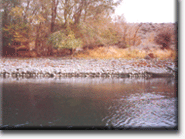 |
 |
Reply to Nez Perce Review
|
|
|
HANFORD RADIOACTIVITY IN SALMON SPAWNING GROUNDS --Quality, Extent, and Some Implications. is an initial, technical response to: Public concern for the long-term strength (or weakness?) of the important salmon stock that spawns in the Hanford Reach of the Columbia Riverbed. The public raised this concern at a conference sponsored by the Government Accountability Project (GAP) in Portland, Oregon in October 1998. In response to that public concern, GAP began an independent contract investigation of radiological contamination of the riverbed of the Hanford Reach. The pre-existing notion of contaminants of Hanford origin in the riverbed where salmon spawn had been of contaminated Hanford groundwater seeping up into the riverbed. Since the mid-1990s, Hanford Site's operator, the U.S. Department of Energy (USDOE) has developed a pump-and-treat program to remove hexavalent chromium from Hanford groundwater seeping into the river near D- and H-Reactors. GAP's investigation began in 1999 to look at contaminated groundwater seeping into the river. The first candidate selected for consideration was strontium-90, a fission product of Hanford's old plutonium production mission. During the unusually high river stages of 1999, GAP's contractor, Norm Buske, sampled leaves of mulberry trees growing along the Hanford shoreline as surrogates for groundwater. --Mulberry leaves take up Sr-90 and provide more replicatable analytical results than groundwater seepage itself, which is sensitive to changes in river stage. Mulberry leaves along the Hanford Reach shoreline revealed some radiological news. New seepages of Sr-90 were found near the K-Basins. Ten-fold background thorium was found downstream of F-Slough, which is downstream from Hanford's production reactors. On the basis of that thorium anomaly, Buske published preliminary findings. In June 2000, GAP's Tom Carpenter requested from USDOE Hanford's records of waste disposals from thorium-related programs. USDOE responded to GAP's request for documents with titles to over 50,000 documents related to production of uranium-233 from thorium at Hanford, relating to U-233 processing campaigns at Hanford's PUREX facility, and relating to waste disposals on site. GAP requested copies of the seemingly most pertinent documents and began to sort out Hanford's history of U-233 operations. Meanwhile, Buske's in-field work focused on characterizing the radioactive wastes in the riverbed, that seemed to be flagged by the anomalous thorium in mulberry leaves downstream of F-Slough. The in-field work made several false starts until the middle of 2001. Buske invited USDOE to jointly sample river sediments, to be sure government agencies and he were on the same page, radiologically speaking. On March 14, 2001, Buske proposed to USDOE to use a new agreement for scientific access to Hanford for sampling purposes as the context for jointly sampling and analyzing sediments in the riverbed of the Hanford Reach. USDOE, Pacific Northwest National Laboratory (PNNL, a Hanford Site contractor), and Buske tentatively scheduled joint sediment sampling sometime during the last ten days of June. That date was later pushed back to the end of August to coincide with PNNL's regular sampling schedule. GAP received no scheduling information from either USDOE or PNNL, and Buske checked back with USDOE on August 27, 2001. A USDOE official informed Buske, "The sediment sampling has been done for this year. The schedule was pushed forward to accommodate the analytical lab to distribute sample load. We are planning to do some additional sampling in the river related to chromium monitoring some time in September or October. ... If you would send me a sample plan we may be able to accommodate you to some extent." On August 29, Buske e-mailed a description of the proposed sampling and asked, "How does [US]DOE/RL want to relate to what is being discovered in the riverbed? If [US]DOE wants to be actively involved (rather than to be reactive to what is published) now is probably a good time..." Later that day, the same official replied, "I will have to pass your question on to my supervisors prior to giving you our answer. Therefore, expect a slight delay before full response is made to your question below [displayed here above]." Buske finished his radiological exploratory investigations in November 2001 and drafted his technical report by the end of December 2001. GAP sent copies of a draft of the December draft and the February 2002 revised draft to government agencies and other reviewers for their information and their comments. As review comments returned, Buske continued edited the report. By May 2002, USDOE had not yet responded more fully to Buske's question: "How does USDOE/RL want to relate to what is being discovered in the riverbed? On May 30, 2002, a reporter for the Tri-City Herald newspaper faxed to GAP's Tom Carpenter a letter from the Nez Perce Tribe. The letter of criticism, dated 28 May 2002, had already been distributed. On May 31, 2002, the Tri-City Herald published the story of the Nez Perce criticism of an early draft of this report: "Nez Perce denounce maverick scientist's Hanford waste theories." Thus has criticism of this technical report reached the public ahead of the report itself. |